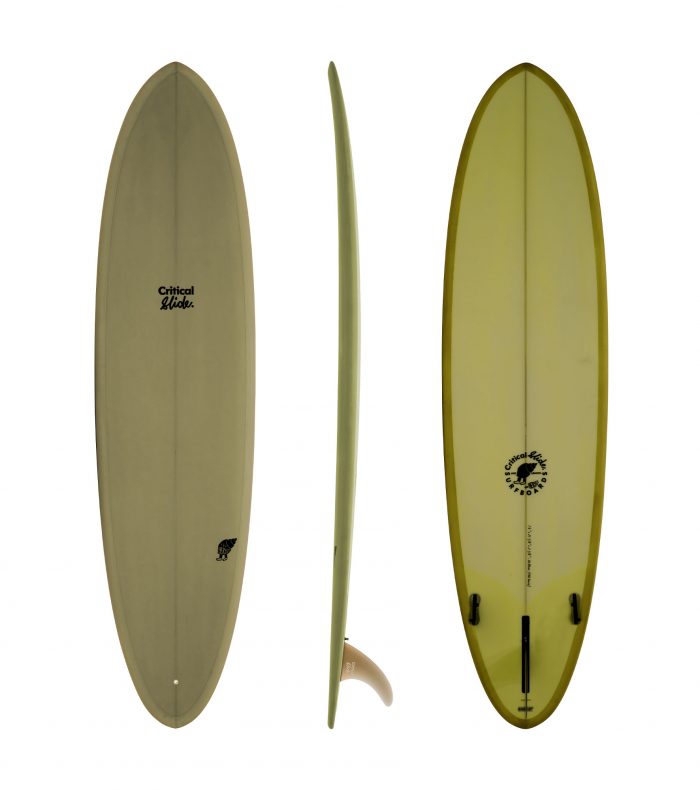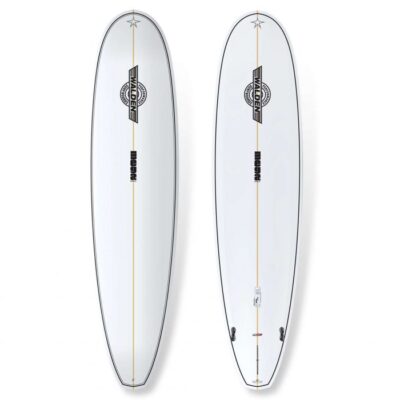Sale!
Critical Slide Hermit PU – FCS II – 2 + 1 – Jade ( 7’6 – 8’0 )
€719.00 – €749.00Price range: €719.00 through €749.00
Critical Slide Hermit PU – FCS II – 2 + 1 – Jade
The Hermit is a mid-length in 3 sizes.
Custom TCSS 7” matte finished centre fin included.
| Dimensions |
Volume |
Fin supplied |
|
|
|
| 7’6 x 21 7/8” x 2 7/8” |
56.0 ltr |
7” Single fin |
| 8’0 x 22” x 3” |
61.0 ltr |
7” Single fin |
Description
CONSTRUCTION: Polyester or PU construction uses traditional materials and laminating techniques to produce a strong, reliable surfboard with high quality finishes. All polyester boards are CNC milled from the shapers files and laminated by hand using quality components such as Hexcel fiberglass, Silmar resin and Bennett foam. For years traditional polyester boards have been at the forefront of performance surfing. These boards feature a progressive flex pattern controlled by a high-grade timber stringer and feel very reliable under your feet. Polyester construction will perform in all surf conditions and can be adapted to suit a wide variety of surfboard models.
Brand
Critical Slide Surfboards
THE CRITICAL SLIDE SOCIETY
One of the guiding lights of The Critical Slide Society brand is the simple joy of surfing. Being in the water catching waves and connecting with yourself, with those around you and with the ocean. We have designed this range of boards with those ideas in mind. No one is going to win a world title on this range of boards. That’s fine by us. The range is all about milking the last drop of fun out of every wave.
The range has been designed to offer a veritable tool box of boards suitable for a variety of conditions. The design characteristics of the shapes have come from putting a current progressive lens over classic surfboard designs. These two longboards, a mid length and a fish will get you around the globe with a smile on your face.
THERE ARE MANY ASPECTS TO SURFBOARD SELECTION THESE ARE THE POINTS TO CONSIDER
LENGTH
Typically surfboards are measured in inches. The length is measured from the nose to the tail. Choosing the length of the surfboard is dependant on your size (weight, height), board type and waves conditions you wish to use the board for.
WIDTH
The widest point of the surfboard is measured from rail to rail. Generally the wider the surfboard the more stable the board, while a board with smaller width maintains better speed and performance.
BOARD THICKNESS
Surfboard thickness is measured from the top deck to the bottom. The thickness again has a bearing on the board’s performance. Professional surfers will tend to go for the thinner boards as they are lighter and offer better performance.The thicker boards are stronger and because there is more foam under the surfer the boards are more stable.
ROCKER
The bottom curve of a surfboard. Generally the more rocker the surfboard has the more loose (manoeuvrable) the surfboard will be. Where the flatter rocker surfboards will be faster, although they will lack the looseness. The nose is the tip of the surfboard, the nose can vary in shapes and size. Basically the thinner the nose the more response the board will perform, while wider noses are better for stabilization.
STRINGER
Used to increase the strength of a surfboard, a stringer (normally made from wood) runs down the length of a surfboards (typically in the centre of the board from the tip of the nose to the tail).
Boards built with Epoxy, Carbon Fibre and soft boards generally don’t have stringers.
FINS
Generally heavier surfers require larger fins to hold the waves better. Although if you prefer to ride a looser (less hold in the waves), smaller fins would be a better option.
FIN CONSIDERATIONS
Fin configurations have an effect on the ways your surfboards perform.
The following are some of the more common fin configurations.
SINGLE FIN
The single fin was the original fin configuration for surfboards. Based on the idea of the sailboat keel. Single fins are added stabilization and control on the powerful, larger waves, although lack manoeuvrability
TWIN FIN
Are great for small waves, being fast and manoeuvrable, but when put into tight spots on larger waves, they become hard to control. Popular with Fish surfboards.
THRUSTER 3 FIN
Widely recognized as the standard fin configuration, the thruster answers the shortcomings of the single fin and the twin fins configurations.
The thrusters give you stabilization, control and manoeuvrability in all types of surfing conditions.
This concept was the brainchild of Australia’s Simon Anderson
QUADS 4 FINS
With four fins in the water, Quads boasts an extraordinary amount of holding power in larger surf.
You may think that having four fins would sacrifice speed by creating more drag, but this is not the case.
The both sets of fins are working together on the rail, which makers believe they creates less drag than a board with a centre fin.
The manoeuvrability isn’t sacrificed either, with fins directly under your back foot, the quads are very responsive.
KEEL
Similar setup to the Twin Fin, although smaller (low profile) fins are generally placed wider (closer to the rails) on the surfboard.
Popular with Fish and Egg / Retro surfboards.
Heeft u hulp nodig bij uw aankoop? Neem dan gerust contact met ons op
+3170 201 5153
info@noordzeeboardstore.nl
Contact formulier



